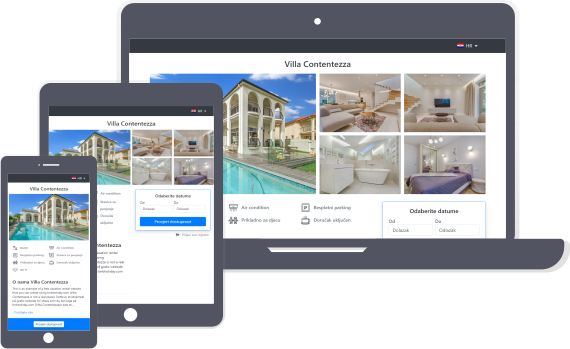Average Daily Rate Calculator
Est. reading time: 9 min
Are you wondering what your Average Daily Rate is? Enter your revenue and the total number of room nights sold to find out.
The room rate calculator will tell you what your Average Daily Rate was during a certain period.
Table of Contents
- Definitions
- Why is ADR important?
- Examples of ADR calculation
- How to interpret ADR numbers?
- How to improve your ADR?
- What is the difference between the Average Room Rate (ARR) and the Average Daily Rate (ADR)?
- What is Hotel Daily Average Room Rate (HADR)?
- What is Hotel Average Room Rate (HARR)?
- Further Reading

Definitions
Average Daily Rate
The Average Daily Rate (ADR) is the average revenue per room night sold in a given period. We can also express it as the average rental income per day per occupied and paid room. For a single day, it is calculated by dividing the total room revenue by the number of rooms occupied that day. Complimentary rooms and rooms occupied by staff are excluded from the calculation.
Total Revenue
The total revenue is the revenue earned by selling the rooms during the period for which the daily rate is calculated.
# of Room Nights Sold
# of Room Nights Sold refers to the total number of room nights sold during the period for which the daily rate is calculated.
# of Days
# of Days is the length of the period for which the daily rate is calculated, in days.
Period
Period refers to the period for which the average daily room revenue is calculated. Common periods are a week, a month, 30 days, or a year.
Why is ADR important?
The Average Daily Rate (ADR) is a metric that tells you what a guest pays per room on average. It is one of the key performance indicators (KPIs) for accommodation providers. ADR lets you easily compare your performance to that of your competition.
By comparing your ADR for different seasons you can compare the amount of room revenue generated. This makes you better equipped to optimize your pricing strategies. That way you can better take advantage of peak seasons and mitigate the effect of the slow seasons.
By understanding how your ADR behaves during different seasons, you can optimize occupancy rates and revenue. This is done by creating guest campaigns and promotional offers to suit the season you are in.
Examples of ADR calculation
To calculate the Average Daily Rate (ADR), we can use the formula:
| ADR = | Room Revenue |
| Rooms Sold · Days |
where Room Revenue is the total room revenue, Rooms Sold is the number of rooms that were occupied and paid for, and Days is the number of days in the period for which the ADR is calculated.
Using the formula above, we can calculate some common Average Daily Rates:
Example 1: Average Daily Rate for a 30 Day Period
Your total room revenue during the last 30 days was $101700.00. 25 of your rooms were occupied and paid for. Then, you can calculate your average daily rate from:
| ADR = | $101700.00 |
| 25 · 30 |
which is equal to $135.60.

Create Your Own Vacation Rental Website
- Booking Calendar
- Multiple Languages
- Guest inquiries
- It's free to try!
Example 2: Average Daily Rate for a Week
Your room revenue for one week was $7861.00. You have 10 rooms that were occupied and paid for during that week. Then, your average daily rate is given by:
| ADR = | $7861.00 |
| 10 · 7 |
which is equal to $112.30.
Example 3: Average Daily Rate for a Single Day
Similarly, for a single day with revenue of $700.00 and 5 occupied (and paid for) rooms, your average daily rate will be:
| ADR = | $700.00 |
| 5 · 1 |
which is equal to $140.00.
How to interpret ADR numbers?
When trying to make sense of your ADR numbers, there is especially one thing you have to be careful about: A high ADR does not by itself mean that your rental business is doing well. You must always interpret ADR numbers together with your occupancy rate.
Your ADR might be high, but if you have a low occupancy rate, you might lose a lot of money because many of your rooms stay unoccupied.
Similarly, if you have a high occupancy rate, but your ADR is too low, you might not make a profit. Even though you are booked solid, it might not be enough because the rates you charge are too low.
To say how your rental business is doing financially, you need to calculate RevPAR or Average Revenue per Available Room. RevPAR combines the ADR and occupancy rate in a single metric and is a good performance indicator for assessing your income.
To get the full financial picture, you will also have to account for all the costs. This might include costs for staff, cleaning supplies, wear and tear, utilities, etc.
How to improve your ADR?
Improving your ADR will improve your bottom line. However, this is only true if the improvement doesn't happen at the expense of an equivalent or greater decrease in occupancy rate or an increase in the cost of operation.
Always analyze ADR numbers together with occupancy rates and operating costs. That way, you will get a full overview of how your business is doing.
With that in mind, here are some tips on how you can improve your ADR and your overall performance:
- Look for opportunities to upsell: When you have premium rooms available, offer your guests to upgrade at a discount. This will enhance their experience with you, and at the same time generate more revenue. Win-win!
- Extras: Offer your guests airport pickup, breakfast, food and beverage welcome packages, massages, local tours and excursions, car or bike rental, tickets to attractions, etc. Along with your advice on what to do and where to eat, this is often a very welcome addition to the accommodation you offer. These extras can create a more comfortable, exciting, and fuss-free stay for your guests.
- Offer package deals: You can package many of the extras mentioned above as a deal and include them in the accommodation package. This can entice more guests to visit and spend more money with you.
- Encourage return guests: Across all business types, it is much easier to sell to a return customer than it is to persuade a completely new person to buy from you. This is true in the accommodation business also. With a little personal touch, you can make your guest's stay memorable and have them coming back year after year. Sometimes all it takes is a welcoming smile and showing an interest in their wellbeing. You should also make sure that the rest of your organization runs smoothly. The rooms have to be nice and clean, the beds comfortable and the atmosphere welcoming. A return guest discount is a great tool for encouraging returns.
- Implement a referral program: Having your guests recruit other guests is where you want to be. Word-of-mouth is a very powerful strategy and can lower your marketing costs substantially. For it to succeed, your guests must be very satisfied with their stay. They must want to tell their friends and acquaintances about you. After their stay, send them an email with a promotional code and a discount to share with their friends and family. This will encourage them to talk about the good experience they've had with you.
- Give discounts for extended stays: By giving discounts for extended stays you encourage your guests to stay with you longer. This is especially useful for boosting your occupancy rates during slow seasons. Try offering 7 nights for the price of 5. If you have a lot of weekend visitors staying two nights only, offer them a 30% discount for the third night. Try different offers of this kind and see if this strategy works for your business.
- Cater to a niche audience: Welcoming pets, catering to families with small children, or reserving your accommodation for adults only makes you stand out from the crowd. This strategy can make you a preferred accommodation provider for a niche audience. Also, your guests are more likely to share their experiences with people they know in the same situation.
- Encourage reviews: Many people like reading reviews from other guests before deciding on where to stay. Having online reviews is essential if you want to attract more guests. Encourage your guests to leave a review after each stay. Sometimes, just asking them to do so nicely is enough.
- Point-of-sale opportunities: Reserve an area at your front desk, or other designated place for point-of-sale opportunities. You can try selling tickets to events, tours, bike or car rental, souvenirs, beach towels, sunglasses, sunscreen, etc. Such offers can create a nice side income. Tourists are often interested in buying local goods and authentic souvenirs. Having a display of local art, food or craft is a great idea.
What is the difference between the Average Room Rate (ARR) and the Average Daily Rate (ADR)?
The Average Room Rate (ARR) is similar to the Average Daily Rate (ADR). They are both key performance indicators (KPIs). They both calculate the average rental income per occupied and paid room. The difference is that ARR is used to calculate the average income for a longer period (usually a week, a month, or 30 days). ADR is used to measure the average rate of a single day. You must see both ARR and ADR in conjunction with the occupancy rate to determine the Average Revenue per Available Room (RevPAR). RevPAR is the main performance metric for hotels and other rental providers.
- Both ARR and ADR are key performance indicators (KPI) for accommodation providers. They make it easier to compare performance across different providers and accommodations.
- You must see both ARR and ADR in conjunction with the occupancy rate to determine how well the accommodation business is performing.
What is Hotel Daily Average Room Rate (HADR)?
Sometimes, complimentary nights are also included in the ADR calculation. We do that to see the impact such nights have on the average room rate. The resulting metric is often called Hotel Average Daily Rate or HADR.
What is Hotel Average Room Rate (HARR)?
Similar to HADR, when free rooms are included in the Average Room Rate (ARR) calculation, the resulting metric is called Hotel Average Room Rate or HARR.
Further Reading
Would like to examine ADR in more detail? Here are some suggestions on where to find more information:
- A nice definition of what average daily rate is found on the ADR Wikipedia Page.
- Statista.com displays a nice overview of monthly average daily rates in the US.
- And, if you want to learn more about hospitality marketing and finances, a good place to start is Hospitality Marketing Management, 6th Edition, by David C. Bojanic and Robert D. Reid.